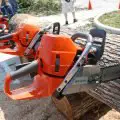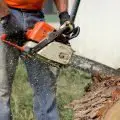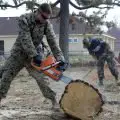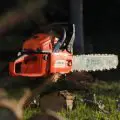A chainsaw is a great tool to allow you to clean up fallen trees, trim unwanted branches, and cut up firewood for your fire. Sometimes they can be rather stubborn when starting up, especially if the chainsaw is a bit old and has endured wear and tear.
There are many different possibilities as to why a chainsaw won’t start, and this will typically depend on whether it’s a gas or an electric chainsaw. To answer your question “why won’t my chainsaw start” in this article, we will provide all the possible problems & solutions to help you get your chainsaw up and running!
Table of Contents
Chainsaw Won’t Start Reasons & Solutions
The main reasons why your chainsaw won’t start are because of a:
- Defective spark plug
- Faulty ignition coil
- Clogged carburetor
- Defective recoil starter
- Broken rewind spring
- Fuel issue
- Activated choke
Let’s take a look at these reasons in more detail!
Defective Spark Plug
If your chainsaw has a defective spark plug, it will not be able to create an electrical current to be able to ignite the system and start the chainsaw. In this situation, you should remove the spark plug and check to see if it is dirty, cracked, eroded, or damaged.
It will also be possible for there to be a heavy carbon buildup or a burned-up electrode. If the spark plug has any of these issues, the simple solution is to replace it with a new one.
Note: The spark plug may appear to be fine visually, but if you haven’t changed it in a while, you should replace it anyway.
You will be able to find spark plug replacements at your local dealership or online, like this example of a Husqvarna spark plug available on Amazon:
Prices pulled from the Amazon Product Advertising API on:
Product prices and availability are accurate as of the date/time indicated and are subject to change. Any price and availability information displayed on [relevant Amazon Site(s), as applicable] at the time of purchase will apply to the purchase of this product.
Faulty Ignition Coil
The ignition coil is the device that sends voltage to the spark plug, creating a spark that ignites the fuel and turns on the chainsaw. It’s likely that a faulty ignition coil will block the engine from turning on, which can simply happen over time with repeated use.
After you have confirmed that the spark plug is not the issue, you should purchase an ignition coil tester and follow the manufacturer’s instructions on how to test the ignition coil. Generally, if a spark does not appear during the testing process, it is very probable that the ignition coil is defective and will need to be replaced to get the chainsaw working.
You will be able to find ignition coil replacements at your local dealership or online, like this example available on Amazon:
- Ignition Module Coil For Poulan. Reference Part Number 530039198 (Please Kindly Refer to the Following Fitment Information or Contact us Anytime Before Purchase)
Prices pulled from the Amazon Product Advertising API on:
Product prices and availability are accurate as of the date/time indicated and are subject to change. Any price and availability information displayed on [relevant Amazon Site(s), as applicable] at the time of purchase will apply to the purchase of this product.
Clogged Carburetor
The role of the chainsaw’s carburetor is to mix air and fuel in order to start the internal combustion engine. Fuel that has been left in the engine for too long can become sticky and clog the carburetor, which will ultimately prevent it from starting.
You should be able to clean out the carburetor if the clog is minor. To do so you will need to drain the fuel and then spray the carburetor with a specialized cleaning solution, before finally wiping it clean.
If the carburetor is heavily clogged up that it would be difficult to thoroughly clean, it likely needs replacing. The carburetor might be damaged or old and therefore no longer functioning as it should. This also applies to carburetors that have been repeatedly cleaned unsuccessfully.
To test whether the carburetor is the problem, first, remove the air filter before pouring a teaspoon of fuel into it, and then pull the starter rope. If the engine starts momentarily and then dies, the carburetor is likely the reason why the chainsaw won’t start.
Therefore, it definitely needs replacing. You will need to purchase one that is compatible with the chainsaw, and then follow the manufacturer’s instructions to switch them out. For the instructions, refer to the user’s manual that comes with the chainsaw, or contact the manufacturer directly if you cannot locate it.
You will be able to find carburetor replacements at your local dealership or online, like this example available on Amazon:
- Fitment:Fit for 45cc 52cc 58cc Chinese chainsaw 4500 5200 Timbertech Silverline Taurus
Prices pulled from the Amazon Product Advertising API on:
Product prices and availability are accurate as of the date/time indicated and are subject to change. Any price and availability information displayed on [relevant Amazon Site(s), as applicable] at the time of purchase will apply to the purchase of this product.
Defective Recoil Starter
A recoil starter is designed to allow the operator to pull up on the starter rope and engage the internal starting mechanisms in order to turn on a chainsaw’s engine. If the recoil starter is defective or assembled improperly, the engine will not be able to start as it should.
You will need to remove the recoil starter assembly from the chainsaw to be able to test whether the recoil starter assembly is defective. The most likely problem with the recoil start is that the pulley system is stuck and will need to be placed back into its proper position. However, this might not always work, so if you do try this and the chainsaw still won’t start, it’ll be time to replace the recoil starter.
You will be able to find recoil starter replacements at your local dealership or online, like this example available on Amazon:
- New High Quality Replacement Recoil Pull Starter.
Prices pulled from the Amazon Product Advertising API on:
Product prices and availability are accurate as of the date/time indicated and are subject to change. Any price and availability information displayed on [relevant Amazon Site(s), as applicable] at the time of purchase will apply to the purchase of this product.
Broken Rewind Spring
The rewind spring is a crucial part of the recoil starter assembly that’s purpose is to rewind the starter cord after each pull. However, if, after the initial pull, the starter cord doesn’t rewind and the engine doesn’t start, then the problem is probably a broken rewind spring, and it will need replacing.
If you’re lucky, your chainsaw model allows for the rewind spring to be replaced on its own. However, other models will require the user to replace the entire recoil starter assembly.
Fuel Issue
A fuel issue is certainly a very common reason why a chainsaw won’t start. It’s possible to accidentally flood the engine with fuel if the chainsaw user has repeatedly been trying to start the chainsaw through the recoil starter system, which will block the chainsaw from starting.
A common indication that the engine has been flooded is the smell of gasoline in the air which you should be able to notice. If you believe the chainsaw engine has been flooded with fuel, you can hold the throttle and pull the starter cord several times, then dry and replace the spark plug, before then trying again to start the chainsaw.
As with the majority of mechanical devices, the quality and quantity of the fuel used in a chainsaw can easily impact its effective operation and functionality. Operators should always first check that their chainsaw is properly fueled so the engine is able to run.
Gasoline will naturally start to deteriorate if it is left unused and sat still, therefore, if the chainsaw hasn’t been started in a while, you must make sure you check that the old fuel hasn’t collected inside the chainsaw. If it has, the gas tank will need to be cleaned and then refilled with new gas.
Activated Choke
Most chainsaws will have a choke position that is used to start their chainsaw in cold weather. This choke setting helps to increase the air and fuel mixture’s richness in the carburetor to improve the fuel flow.
However, if the choke is activated in mild or warm weather situations or after the chainsaw has warmed up itself from being in use, it will quickly flood the engine as the engine does not need that amount of heat to start.
If the operator is troubleshooting the chainsaw at a warm or mild temperature, they should double-check to make sure the choke is not activated. If it has been on, the engine may be flooded, which can be resolved using the steps above.
To learn how to safely use a chainsaw, visit our guide here!
If you find that your chainsaw still won’t start after attempting these troubleshooting solutions, it is time to call in a specialist or invest in a replacement. If you don’t have time to wait around for a fix and need branches trimmed or a tree removed immediately, you can always reach out to a professional who can handle the job for you while you figure out what your next step is, and whether you need to research the best chainsaws as a replacement.
FAQs (Frequently Asked Questions)
What would cause a chainsaw not to start?
There are many reasons why a chainsaw won’t start, these include a defective spark plug, faulty ignition coil, clogged carburetor, defective recoil starter, broken rewind spring, fuel issue, or an activated choke. You will need to conduct a series of tests to figure out what your issue is and then take the necessary steps to either clean or replace said part of the chainsaw.
How do you get a chainsaw to start that’s been sitting?
In most cases, you will need to let the saw sit for 30 minutes to allow the excess gas to evaporate. You should remove the spark plug, dry it, and then crank over the engine a few times to dry the cylinder. Now refit the plug and try to start the chainsaw again. Set the switch to “On”, set throttle to fully open, set choke to “Off” and crank over the engine.
How long to wait if chainsaw is flooded?
This rather simple process which will help your chainsaw if it is flooded is to let your chainsaw sit for 15-20 minutes to allow the fuel to evaporate from the engine and then repeat the starting instructions. In some cases, it may be worth letting the chainsaw sit for 30 minutes.
What would cause a Stihl chainsaw not to start?
The reason a Stihl chainsaw won’t start is likely because it is has a faulty ignition coil, clogged carburetor, defective spark plug, fuel issue, defective recoil starter, broken rewind spring, or an activated choke.









